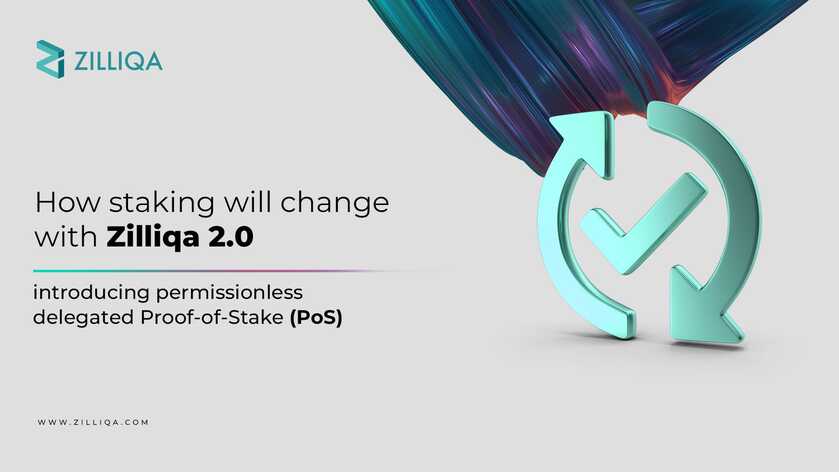With the upcoming rollout of the new Zilliqa 2.0 network, significant changes are coming to how staking works.
With Zilliqa 2.0, we are introducing a permissionless delegated Proof-of-Stake (PoS) mechanism for validator selection. This transition will reshape the way staking functions on the Zilliqa network, enhancing security, decentralisation, and efficiency.
The move to Proof-of-Stake with Zilliqa 2.0 is a fundamental shift in the architecture of the blockchain that will improve transaction throughput, reduce operational costs, and create a more energy-efficient and decentralised network.
To learn more about Proof-of-Stake, read our previous blog post.
With this transformation, the way users stake their ZIL tokens and earn rewards will also be updated to align with the new consensus mechanism.
How staking currently works on Zilliqa
Staking was introduced to the current Zilliqa network to incentivise Staked Seed Nodes (SSNs), which serve as archive nodes and maintain a historical record of transactions. They also offer API access and receive a share of block rewards in return for their services.
Staked Seed Nodes (SSNs) must stake a minimum of 10 million ZIL to be eligible for staking rewards. A verifier mechanism probes the individual SSNs' availability and calculates their rewards according to their performance. ZIL holders have the option to delegate their tokens to an SSN, and earn a share of the rewards generated by that SSN. Delegators can withdraw their stake at any time, and if the withdrawn ZIL amount leads to that SSN’s stake falling below the required minimum, that node stops earning rewards.
When a delegator withdraws their stake, there is a 14-day unbonding period before their tokens are unlocked. This period will be retained on Zilliqa 2.0 and can be changed by decentralised governance vote.
This legacy staking system is permissioned, with SSNs needing to be registered with the SSNList smart contract, controlled by the Zilliqa team, to be eligible for rewards.
ZIL holders can delegate their ZIL to SSNs through Zillion, the staking interface available at stake.zilliqa.com which provides information on active SSNs and allows users to claim their rewards.
This legacy staking mechanism has been integrated with a number of exchanges and wallets in the Zilliqa ecosystem, with apps like Torch Wallet building on this system to offer tools such as instant unstaking and reputation.
Other examples of innovative tools built on Zilliqa’s current staking mechanism include the first liquid staking launched on the network, stZIL, which delegators can receive by staking through Avely Finance.
Learn more about Staked Seed Nodes (SSNs).
With the launch of Zilliqa 2.0, the network will adopt a permissionless, more decentralised Proof-of-Stake system where staked ZIL actually plays a role in securing the network.
Staking on Zilliqa 2.0
To improve transaction throughput, finality, operational costs, and energy efficiency, Zilliqa 2.0 shifts its consensus model from Proof-of-Work (PoW) to Proof-of-Stake (PoS).
Instead of being secured by a network of PoW nodes performing expensive computations on hardware that consumes vast amounts of energy, validators on Zilliqa 2.0 are PoS nodes that emerge from the existing Staked Seed Nodes (SSNs), who stake ZIL as collateral to secure the network.
Rewards will be distributed amongst validators on a per-block basis proportional to their stake but depending on their performance, providing them with an incentive to maintain network security and efficiency.
50% of the epoch rewards (51,000 ZIL per 3,600 blocks) are distributed among the validators based on how many blocks they proposed. If they together manage to propose 3,600 blocks in an hour (maintaining a one-second average block time) they will earn 51,000 ZIL in an hour. If the block time increases, validators will need to work longer for the same 51,000 ZIL.
The other 50% of the epoch reward is distributed among validators based on how many times they voted for a block proposal, allocated to the fastest two-thirds of validators weighted by stake.
Zilliqa 2.0’s staking model consists of a permissionless system with two layers. The deposit contract acts as a system contract that enables anyone with the minimum stake to become a validator.
Delegation contracts interact with the deposit contract and can be deployed by validators to receive delegated stake. Validators which do run a staking pool to accept delegated ZIL are referred to as solo stakers.
We have created two reference delegation contracts: a non-liquid staking variant that allows delegators to withdraw rewards manually and a liquid staking variant that issues a non-rebasing liquid staking token whose increasing price reflects accrued rewards. These contracts have been developed in Solidity and will be audited before being made publicly available.
This means that ZIL holders will still be able to delegate their tokens to validators and earn a proportional share of the rewards for helping to secure the network. While rewards can be claimed immediately, withdrawals and validator switching will be subject to an unbonding period to maintain network stability.
This unbonding period is crucial to the security of the protocol, as it prevents validators from withdrawing their stake before they are punished for misbehaving. There are two penalties introduced for dealing with bad validators in Zilliqa 2.0: slashing stake for safety violations (equivocation) and jailing for liveness violations (missing blocks).
To facilitate the transition to Proof-of-Stake with Zilliqa 2.0, a staking portal will be introduced to the Zilliqa website, providing an easy way for ZIL holders to delegate their ZIL to listed validators.
Next steps for stakers and validators
Once Zilliqa 2.0 is live on mainnet, new PoS validators and SSN operators will need to set up and operate a node on the new Zilliqa 2.0 network and stake the minimum amount of ZIL to the deposit contract to join as a validator.
These node operators can then deploy delegation contracts to enable ZIL holders to stake ZIL through their node. The Zilliqa team will provide reference contracts and guidance for easy deployment.
Users who have delegated ZIL through SSNs will also need to manually move their stake to the new staking contracts once the mainnet migration is completed.
The upcoming EVM staking portal will ensure a seamless transition, making it easier for users to delegate and manage their stake within the upgraded ecosystem.
All the systems above will first be available on the Zilliqa 2.0 proto-mainnet, giving ZIL holders and validators the chance to test out the process of migrating their staked ZIL and running a validator node on the new network.
We will shortly be publishing a full guide on how to move your staked ZIL to Zilliqa 2.0, so stay tuned to our blog and socials for the latest updates!




























